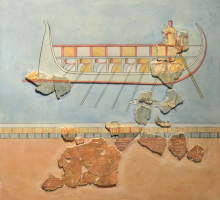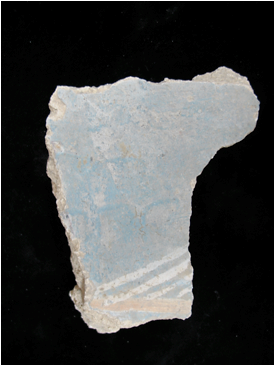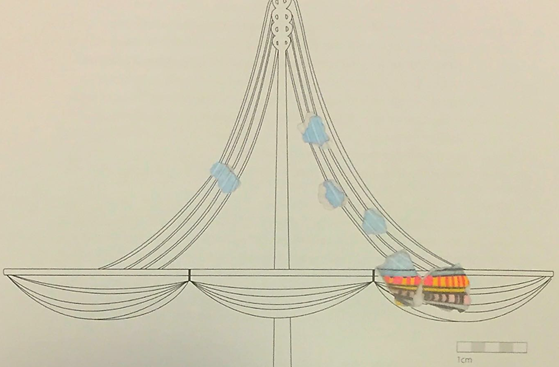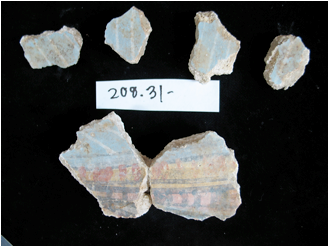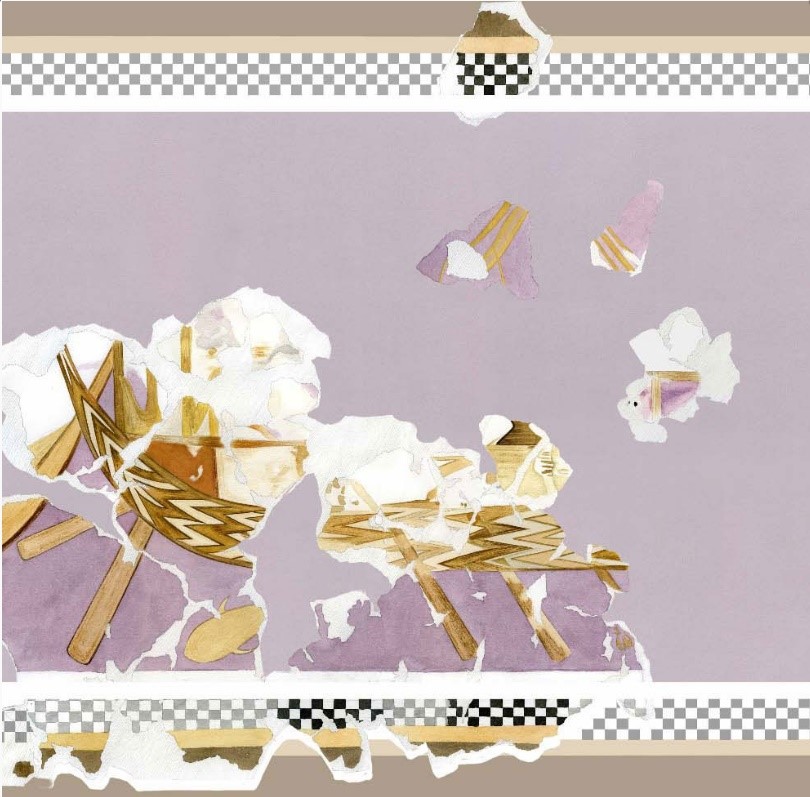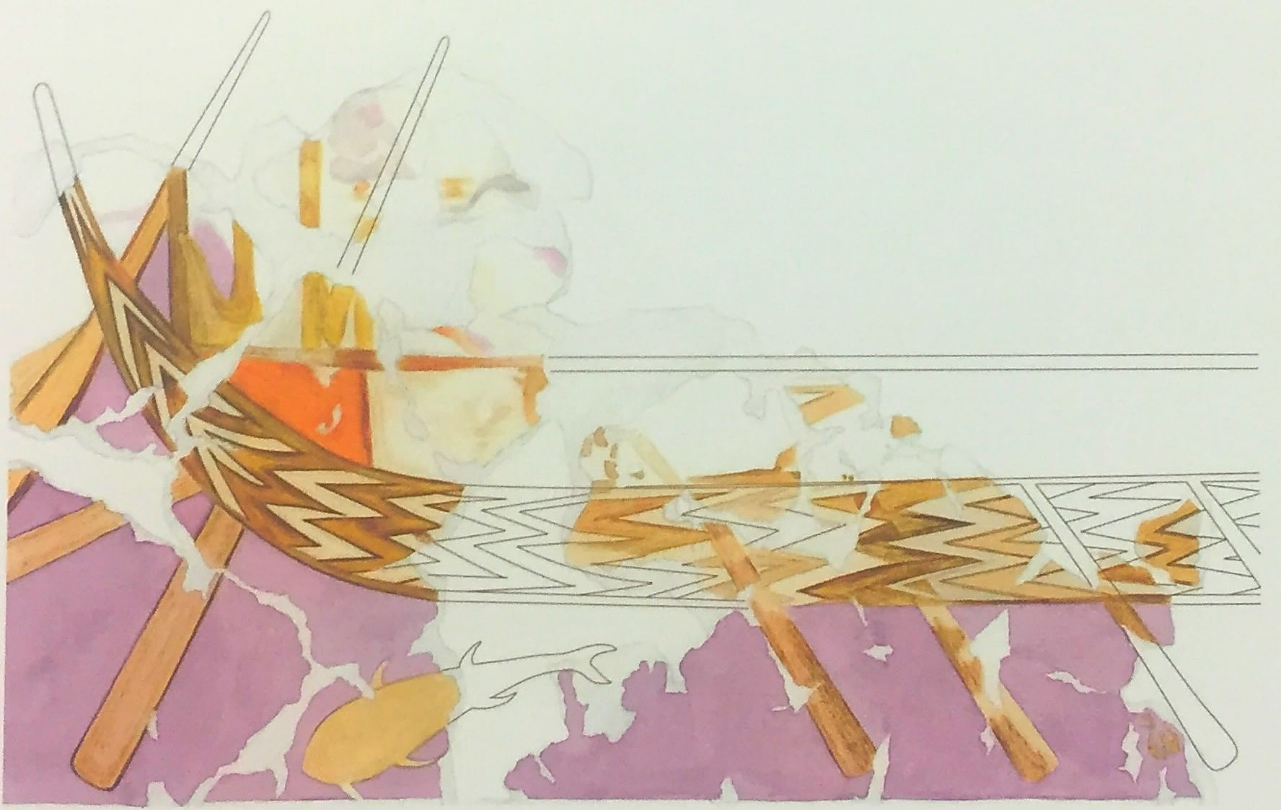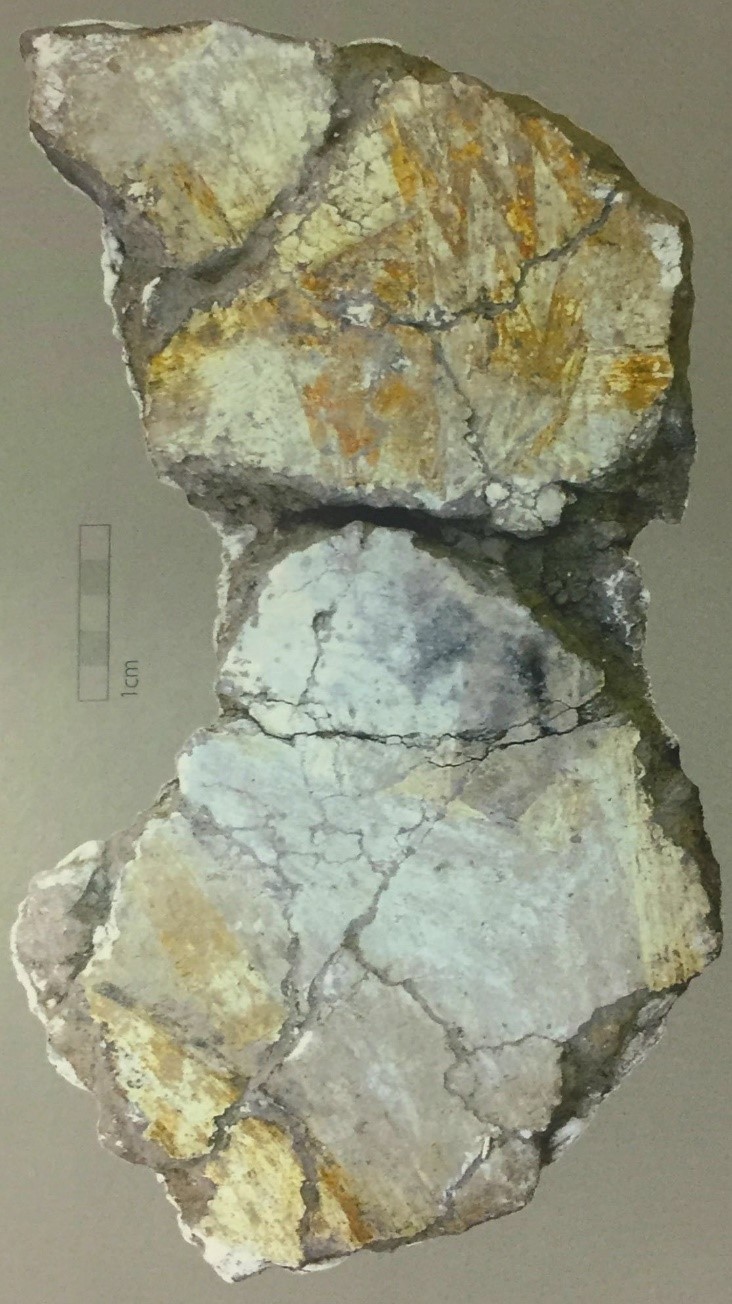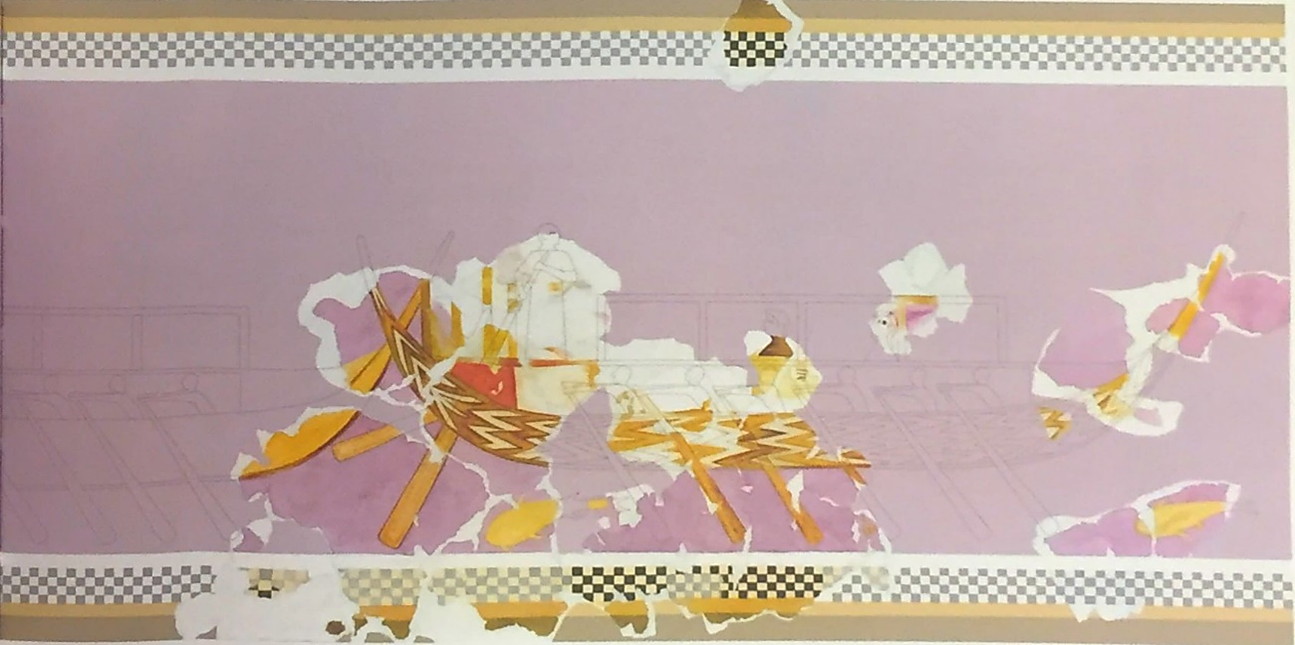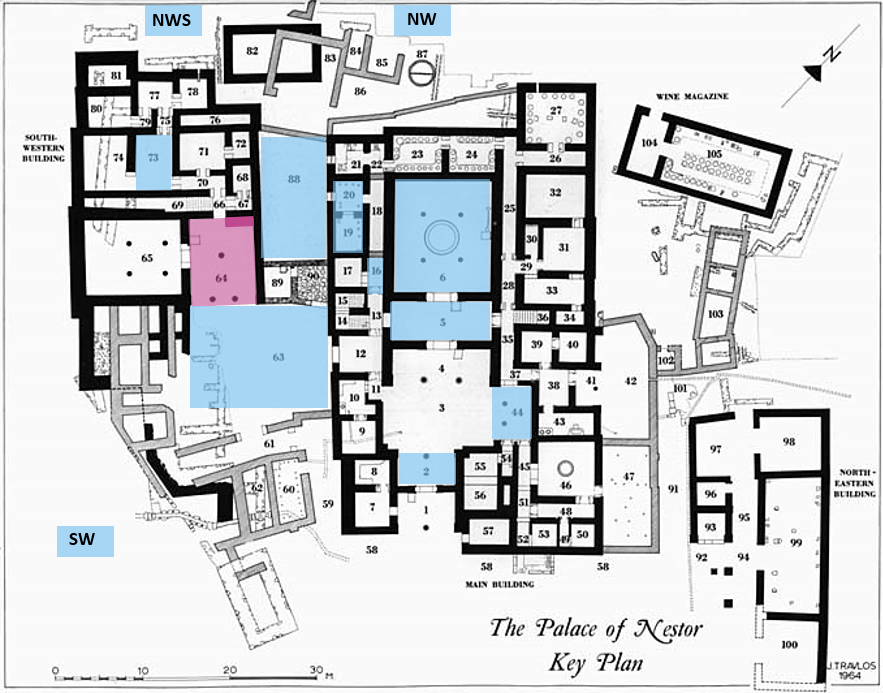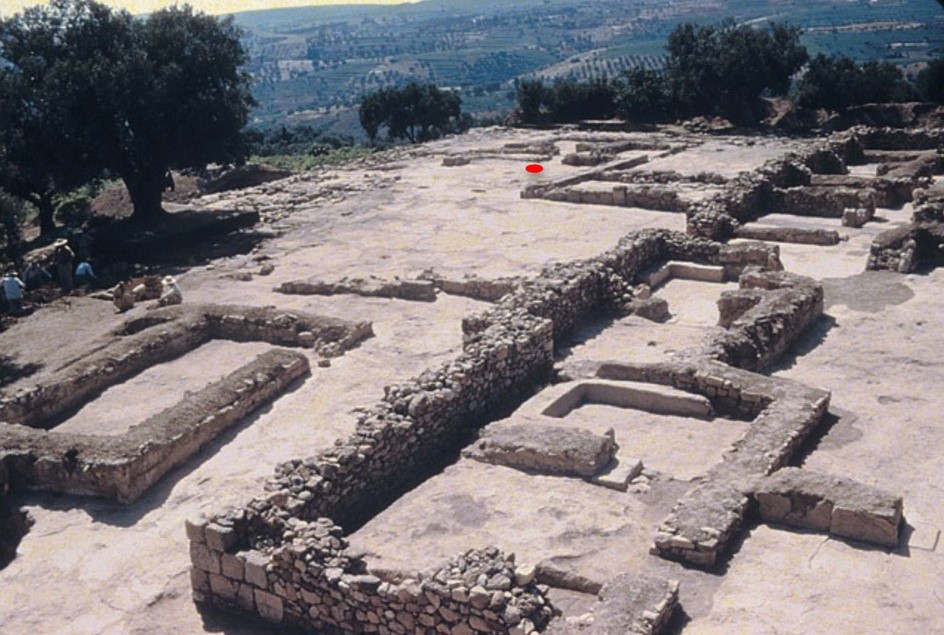A2a (fragmentary ship, rigging only): Two fragments from a fresco
dump on the slope northeast of the palace, with further pieces
discovered later at the Khora Museum, including one from Room 31 showing
parts of a boom and rigging which are probably part of the same
composition. Stratigraphic and architectural evidence suggests that the
fragments originally came from Hall 64, which if true would provide
evidence of a predecessor to the naval fresco prior to the hall's
rebuilding in LH IIIB. Black, white, yellow and blue paint, with a black
and white checkerboard pattern at the top similar to that of the
composition of A1a-c. This checkerboard pattern further supports the
conclusion that these fragments probably came from Hall 64, although the
motif is also encountered elsewhere (Rooms 5 and 20). Parts of a yellow
mast and yard. Masthead, four deadeyes, and four halyards on each side
(only 3 preserved on the right) painted in white against a blue
background. A1e confirms that the square-sail with yard and boom was
still prevalent on Mycenaean ships of the 14th century.
A2b (fragmentary ship, rigging only): Fragments with rigging and
possibly parts of a furled sail from area MZ, on the slope southwest of
Hall 64. Similar color scheme to A1e, so probably from the same
composition but a different ship.
A2c (lead ship): Surviving sections include large parts of the
stern, a mid-section of the hull, and small fragments of the bow. Ship
to the right with a crescentic hull and gently rising posts which taper
towards their extremities. The sternpost possibly rises at a sharper
angle, similar to the Cretan vessels. Traces of three rectangular oars.
Two rectangular-shaped steering oars cross the hull diagonally, one to
port and one to starboard. Traces of yellowish-brown paint above the
stern are possibly remnants of a figure (helmsman). Evidence of wooden
superstructure amidships (awning), most likely cabins with divided
compartments given the evidence for people inside. A brown line at the
stern probably represents a deck that probably supported a small
structure (ikrion). The hull is decorated with a complex vertical
zig-zag pattern made up of dark and light brown hues.1
A2d (middle ship): Surviving sections include parts of the stern
(including both steering oars and one oar) and small parts of the bow,
while the mid-section is missing completely. Same as A1a except that the
hull is not decorated. Several incised lines on a non-joining fragment
are though to be related to the muddle ship given the thickness of the
plaster. These possibly depict rigging elements.
A2e (rear ship): Surviving sections include most of the aft section
of the ship (including one of the steering oars and three oars) and a
very small part of the stempost. As on the lead ship, there is evidence
of a superstructure amidships (awning) which is probably cabins with
divided compartments. One person within is still preserved. There are
additional traces of three posts (two vertical and one horizontal) on
the stern which must belong to another type of superstructure or a
wooden object (most probably ikrion). Behind them there is an area of
mottled black and white paint which is difficult to interpret. The
elliptical shapes discernible in the design possibly suggest either
stones or stone-patterned cloth. Same as A1a except that the hull is not
decorated.
A2f (argonauts ship): From the northern corner of Hall 64. This
vessel has a hull of comparable dimensions to A1a-c and probably
belonged to a frieze of comparable height. Surviving sections include
parts of the bow and even smaller fragments from amidships. The
discernible elements are a small section of the gunwale as it curves
upwards gently into the stempost, parts of a deck, three oars, and the
beginning of a vertical post from a cabin (awning). The position of the
oars was marked out with shallowly incised lines. The hull is decorated
with argonauts (characteristic upraised curled tentacles with red dot
centers) along its length, crossed intermittently by diagonal oars (c.
every 6 cm). The direction of the Argonauts to the right probably
indicates the direction of the ship itself.
A2g (second argonauts ship): Another set of fragments from Hall 64
possibly represent a second ship decorated with argonauts. It shows
parts of two animals facing right, represented in purple paint against a
white background bisected by a yellow sawtooth band. The lower edge of
this band has a gentle upward curve (possibly a hull) below which is
purple ground (possibly sea analogous to the Naval scene).
1. The zig-zag motif occurs in Pylos in other contexts, such as on a large-scale skirt and a number of painted floor squares in the palace's megaron.
Naval fresco fragments
A2a-g
A2a-b: LH IIIA (?); A2c-g: LH IIIB
Palace of Nestor, southwest building, Hall 64, northwestern wall (upper part, northeastern end)
Frieze L: 2.50 m; H: c. 0.65 m
Polychromatic fresco, surface of the plaster severely damaged by fire
Khora Archaeological Museum
Brecoulaki 2018: 402-404, figs. 13, 15-16; Brecoulaki et al 2021; Brecoulaki et al 2015; Egan and Brecoulaki 2015: 297, figs. 14, 15; Kokiasmenou 2018: 57, 76-77, 79-81, figs. 5.3, 6.1-6.5; Lang 1969: pl. 113: 19 M ne; Shaw 1980: 177-178, fig. 12; Shaw 2001; Tartaron 2013: 60; Wachsmann 1998: 96-97, fig. 6.22; Wedde 2000: 84-85, 325, no. 652
Hall 64: Building A was one of 2-3 buildings which were built on the Ano Engalianos acropolis in LH IIIA (Nelson 2001: 201.). Built of ashlar masonry on the edge of the acropolis plateau, it provided the basic unit that later formed Hall 64 and Hall 65. Given that the walls of Hall 64 were rebuilt in LH IIIB when Building A was transformed into the Southwestern Building, it is virtually impossible that the wall paintings which fell from in the final destruction could have been residual from a decorative program of the 14th century. The Southwestern Building is older than the Main Building of the palatial complex. In its final form, the building was two storied at least partially. Hall 64 commanded an important position within the overall palatial complex at Pylos, and was likely one of the first palatial structures to confront visitors given that the main ancient approach to the citadel probably led first into Court 58. From there, a narrow dog-legged passageway led northwest through ramp 59, which then turns southwest through a doorway into Corridor 61, leading to a larger doorway at the southeastern side of a large courtyard (Court 63) which faced Hall 64. From Hall 64 itself, it was possible to enter Hall 65 by turning left, or alternatively to continue straight into a network of interconnected rooms to the northwest. Located between Hall 64 and the Main Building, Court 63 and Court 88 were possibly loci for feasting, for which tablewares were provisioned from Room 60 and the pantries (Rooms 18-22) of the main building.
Hall 64 opened to the southeast. It had two columns set between squared projecting antae, with another column standing in the center of the room on its central axis. In the middle of its northwest wall was a narrow doorway which led to a staircase rising southwest, while a broader door centered in the southwest wall led to Hall 65. To its immediate northwest was a small plastered platform which was probably a sentry stand. The naval scene would have been visible from Court 63 and would have immediately attracted the attention of viewers as they entered the Hall. Since the wall decoration of this room took the form of friezes, it would have been originally positioned at eye level, with two large friezes below it decorated with other motifs (a dado and possibly a frieze of hunting dogs like those of the northeastern wall).
Argonauts motif: Examples of argonauts were originally identified from six different contexts: the inner Propylon (Room 2), Room 16, Room 20, and from plaster dumps to the northwest and southwest of the palace. Since then, 53 additional fragments have been located and linked to Rooms 2, 5, 6, 19, 44, Court 63, Hall 64, Room 73, Court 88, and the Northwest Slope Plaster Dump. Although argonauts are known from elsewhere (Knossos, Gla, Mycenae), its notable ubiquity within the Palace of Nestor - both during its earlier and later phases of construction - suggests that it held a special significance, possibly as a royal "totem" of the Pylian state (Egan and Brecoulaki 2015: 30). A large-scale argonaut reconstructed from a group of joining fragments which came from the Throne Room and Room 19 respectively possibly originally adorned the southwestern wall of the Throne Room. If this interpretation is correct, the argonaut would have been positioned centrally on the Throne Room's southwestern wall (as suggested by the joining fragments from Room 19). In this location it would have faced the throne directly, providing support to the hypothesis that the motif acted as a symbolic "reflection" of the wanax and the power of his fleet. Nor was this the only marine motif in the Throne Room, since a large octopus was also painted on the floor in the front of the throne. The use of an argonaut on the blade of a dagger from Tholos II at nearby Rousi dated to LH I/IIA hints that the motif may have already held special significance much earlier.
The use of argonauts to decorate the hull of ship A1d from Hall 64 (as well as possibly a second ship) further strengthens their interpretation as emblems of naval power connected to the Pylian projection of maritime dominance. Egan and Brecoulaki point to a later myth recounted by Aristotle (Hist. an. 622b 5-15, 525a 22-25) where the argonaut was likened to a skilled sailor, sailing about in its boat-shaped shell by rowing with its arms and catching the wind in its dorsal webs. They wonder whether the unusually large eyes (duplicated in the curls of their tentacles) of the argonauts decorating the hull possibly served an apotropaic role comparable to later eyes painted on Greek galleys from the Geometric period onwards. Overall, based on the creature's iconography and its contextual associations, the Pylian argonauts were clearly more than mere decorative border elements and had a strong emblematic character connected to state power and the navy more specifically.
Color Scheme (A2c-e): All the surviving elements of the ships are rendered in lighter and darker tones of brown and yellow. The ships lack the richness in color and decoration of the Theran fleet, and instead even the fish were colored in a manner that seems to respond to the overall chromatic austerity characterising the scene. Further analysis using MA-XRF imaging suggests however that the original polychromy of the hulls was more varied than previously suspected, with a chromatic alteration of the zig-zag lines in yellowish-brown and a cooler hue of blue (Kokiasmenou 2018: 81). The lines outlining the sheer and keel of the hull are dark brown, with the mass of the hull being a lighter yellowish brown. For the zig-zag pattern decorating the hull of the lead vessel, the artist combined paints of dark and light brown hues. Besides carbon black and calcium carbonate white, the only other color employed is a light purple used for the sea. Brecoulaki et al note: "The combination of purple and yellowish-brown hues conveys a delicate and appealing effect that is based on the harmony of complementarity and points to a use of color more sophisticated than the "primitive" tricolor scheme of yellow-red-blue typically employed in Mycenaean painting." (Brecoulaki et al 2015: 276). All of the pigments used for the ships were iron-based ochers, while the color of the sea was obtained by mixing murex purple with tiny grains of Egyptian blue. As the most expensive pigment, murex purple was employed only selectively in certain rooms of the palace, which emphasizes the symbolic value of the representation. Pigments were applied in a secco technique, with both eggs and vegetable gums (principally tragacanth) used as binders.
Composition (A2c-e): Three seagoing ships sailing to the right against a purple sea with swimming fish. Their prows and sterns overlap slightly, a paratactic disposition which recalls the overlapping arrangement commonly seen in Egyptian naval reliefs. The order of the ships is provided by a fragment showing the stempost of the lead ship, as its right edge curves upwards, thus indicating that it abutted against a vertical beam or corner marking the end of the frieze. The fish swim to the left, in the opposite direction of the ships. The upper and lower border of the composition is framed by a four-rowed black and white checkerboard pattern that was also used for the battle scenes in Hall 64. The most characteristic aspect of the composition is the regularity and symmetry with which the ships and fish are depicted. Due to its fragmentary nature, is not clear whether the scene is located in a harbour or in the open sea, nor is it possible to determine a possible narrative. A naval expedition, a festival, or a parade to showcase the Pylian fleet are all possibilities.
The hulls of the ships vary in length from 0.70 to 0.90 m. Based on this estimation, the original number of rowers must have been six. The long and slender hull morphology is unmistakably that of Minoan vessels (Wedde type IV). The depiction of two steering oars is also typical for this type, but unusual for Mycenaean galleys. The main difference is that there is no clear distinction between the bow and stern of the Pylos ships. However, since none of the post extremities are preserved, it is uncertain whether or not they were the same height or whether the stempost was longer.
Brecoulaki, H. 2018. “Does colour make a difference? The aesthetics and contexts of wall-painting in the ‘Palace of Nestor’ at Pylos. In A.Vlachopoulos (ed.) Paintbrushes. Wall-Painting and Case-Painting of the Second Millennium BC in Dialogue. Athens: Hellenic Ministry of Culture and Sports, pp. 391-406.
Brecoulaki, H., A.G. Karydas, V. Perdikatsis and M.P. Colombini 2021. “Re-presenting in colours at the ‘Palace of Nestor’: Originakl polychromy and painting materials,” In J. bennet (ed.) Representations. Material and Immaterial Modes of Communication in the Bronze Age Aegean. Sheffield Studies in Aegean Archaeology. Oxford: Oxbow, pp. 53-106.
Brecoulaki, H., S. R. Stocker, J. L. Davis, and E. C. Egan. 2015. “An Unprecedented Naval Scene from Pylos: First Considerations,” in H. Brecoulaki, J. L. Davis, S. R. Stocker (eds.) Mycenaean Wall Painting in Context: New Discoveries, Old Finds Reconsidered. ΜΕΛΕΤΗΜΑΤΑ 72. Athens: National Hellenic Research Foundation / Institute of Historical Research, pp. 261-291.
Egan, E. C. and Brecoulaki, H. 2015. “Marine Iconography at the Palace of Nestor and the emblematic use of the Argonaut,” in H. Brecoulaki, J. L. Davis, S. R. Stocker (eds.) Mycenaean Wall Painting in Context: New Discoveries, Old Finds Reconsidered. ΜΕΛΕΤΗΜΑΤΑ 72. Athens: National Hellenic Research Foundation / Institute of Historical Research, pp. 293-313.
Kokiasmenou, E. 2018. “Portable XRF analysis and MA-XRF Imaging of Mycenaean WallPainting Pigments from the Palace of Nestor at Pylos.” Msc Thesis, Aristotle University of Thessaloniki, Thessaloniki, Greece.
Lang, M. B. 1969. The Palace of Nestor at Pylos in Western Messenia: Vol. II, The Frescoes. Princeton: Princeton University Press for the University of Cincinnati.
Shaw, M. C. 1980. “Painted “Ikria” at Mycenae?” AJA 84.2: 167-179.
―――. 2001. “Symbols of Naval Power at the Palace at Pylos: The Evidence from the Frescoes,” in S. Böhm and K.-V. von Eickstedt (eds.) Ithaki: Festschrift für Jörg Schäfer zum 75. Geburtstag am 25. April 2001. Würzburg: Ergon Verlag, pp. 37-43.
Tartaron, T. F. 2013. Maritime Networks in the Mycenaean World. Cambridge: Cambridge University Press.
Wachsmann, S. 1998. Seagoing Ships & Seamanship in the Bronze Age Levant. College Station, TX: Texas A&M University Press.
Wedde, M. 2000. Towards a Hermeneutics of Aegean Bronze Age Ship Imagery. Peleus Studien zur Archäologie und Geschichte Griechenlands und Zyperns, vol. 6. Bibliopolis: Mannheim and Möhnsee.



